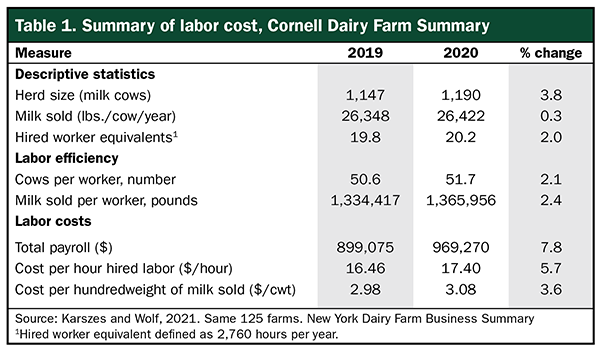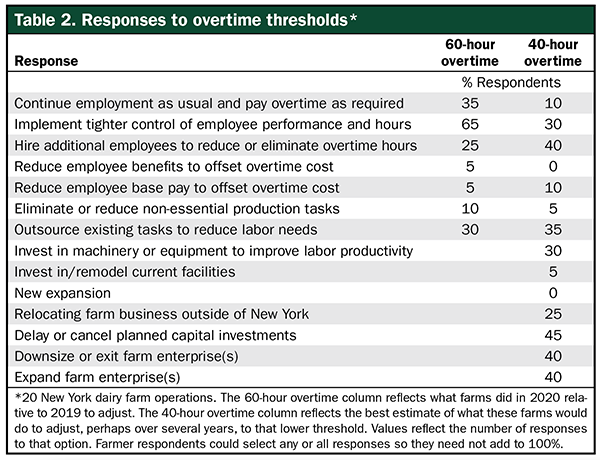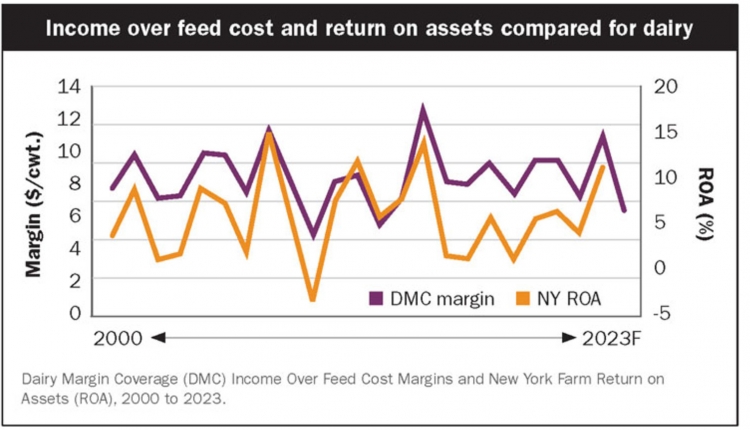The authors are a professor at the Dyson School of Applied Economics and Management, a dairy management specialist, and an agricultural workforce specialist, all with Cornell University.
The Fair Labor Standards Act (FSLA) of 1938 is a federal law that created the right to a minimum wage as well as overtime pay when people work more than 40 hours a week. The federal minimum wage was 25 cents per hour when it was introduced in 1938, and it has been adjusted upward over time. Since July 2009, the federal minimum wage has been $7.25 per hour.
While there are some exceptions for agricultural workers, most workers are subject to the federal minimum wage. States can enact their own laws regarding minimum wage and require employers to pay more than the federal minimum wage. However, for states that do not establish their own minimum wage laws, or if agricultural workers are not included in the state’s minimum wage laws, federal law applies. Some states have raised minimum wage above this level, reaching as high as $15 per hour. The impacts of this increase vary depending on the local or regional labor market, the industry, and job expectations.
With respect to overtime, as defined in the FLSA, agricultural workers were exempted. As a result, in states where there are no overtime laws or where state overtime laws do not cover agricultural workers, these workers do not have legal rights to overtime pay. However, in recent years, some states have implemented their own laws that specifically require overtime pay for agricultural workers, including many of the top milk producing states. Specifically, California, Minnesota, New York, and Washington — all top 10 milk production states — have some version of overtime requirements for farm workers. We recently examined the impacts of these labor law changes in New York and considered the implications for dairy farms and the industry.
The New York case
The New York Farm Laborer Fair Labor Practices Act regulating state farm employers went into effect on January 1, 2020. Under the Act, overtime, weekly day of rest, collective bargaining, and enhanced insurance requirements were put in place for most frontline, nonfamily farm employees. An overtime threshold for hired employees in New York agriculture was established at 60 hours per week and remains there at the current time.
With one complete year on the books, we examined cost implications of the 60-hour overtime threshold by comparing 2020 (overtime mandated) to 2019 (no overtime mandated). For most farms participating in the Cornell Dairy Farm Business Summary and Analysis Project (DFBS), hired labor is the second largest expense category after purchased grain and concentrates. In 2019, on New York farms participating in the DFBS, hired labor sources provided an average of 85.7% of the labor hours. Table 1 displays farm and labor summary statistics for 125 dairy farms that participated in the DFBS in both 2019 and 2020.

At 5.7%, the 2020 farm financial summaries had the highest annual percent jump in hired labor costs per hour over the last 10 years. Overall, hired labor cost rose to $17.40 per hour. This wage inflation was driven by a combination of higher gross wages, including a 70-cent minimum wage increase, overtime, as well as growing business share of employment taxes, workman’s compensation, and other benefits provided to employees.
Along with this escalation in cost per hour, additional hired hours of labor were utilized, with 2% more in hired worker equivalents. This led to an increase of total payroll on participating farms of 7.8%.
The additional hired labor utilized on the farms was associated with a growth in farm size. From 2019 to 2020, farm size climbed by 3.8% to an average of 1,138 milking and dry cows. With the growth in herd size greater than the additional demand in hired labor utilized, labor efficiency as measured by cows per worker equivalent improved by 2.1% to 51.7 cows per worker. If cows per worker had stayed the same in 2020 as 2019, the farms would have had to bolster hired labor by an additional 4.3% versus the 2% that was needed with the growth in cows per worker equivalent. This increase in cows per worker, coupled with a small gain in milk sold per cow, resulted in an improvement of 2.4% in milk sold per worker equivalent.
Total labor cost per hundredweight of milk sold climbed 3.6% to $3.08 per cwt. This upward movement in cost per hundredweight was less than the higher cost per hired hour of labor due to the improvement in labor efficiency, measured by the 2.4% gain in milk sold per worker. If the farms had not been able to improve labor efficiency, the inflation in cost per hired hour would have resulted in a cost of $3.21 per hundredweight, an additional 14 cents more than what actually occurred.
Strategies and reactions
When hired labor becomes more expensive, there is incentive for management changes such as substituting capital (technology) for labor where possible. Through a series of interviews with 20 New York dairy farmers in the summer and fall of 2021, information was collected on the operational and management changes made in response to overtime laws. The most common response to overtime regulations was implementing tighter control of employee performance and hours. For the 60% of respondents who chose this response, tighter control included strict scheduling, performance monitoring, reorganizing positions and roles, additional training, and even limiting hours below the 60-hour threshold in some cases. A couple of farm managers mentioned that they took on additional tasks themselves to minimize overtime hours.
Another common response included continuing employment as usual and paying overtime. This was feasible on some farms because the average hired employee workweek was less than 60-hours per week or the number of hours over 60 was not enough to lead to changes in management practices. Thus, continuing employment as usual was the response on about one-third of the farms under a 60-hour overtime threshold.
Investment action
More than one-third of farms also invested in machinery or equipment to either supplement or substitute for labor. Examples of this investment included equipment intended to speed up planting and harvesting, automatic feed pushers or manure scrapers, and activity monitors for cattle.
A quarter of respondents indicated that they hired additional employees to reduce or even eliminate overtime hours. Many other farms indicated that they would have preferred to hire additional employees, but they were unsuccessful in finding candidates. Other issues related to adding employees included the potential need for housing, which is a long-term investment, and management time for starting, training, and monitoring new employees.
A quarter of respondents shared that they outsourced existing tasks to reduce labor needs. Examples included hiring custom crop planting or harvesting as well as manure hauling. Less common were farms reducing base pay or benefits for employees, although both did occur. Many farm managers mentioned the competitive nature of labor today and the need to maintain workforce.
Can overtime go lower?
In January 2022, the three-member wage board voted to recommend that a 40-hour overtime rule for farm workers be phased in over the next 10 years. In our interviews in the summer and fall of 2021, dairy farmers were queried about potential response to overtime thresholds at 40-hours per week. This exercise was hypothetical at the time, as no move to 40 hours had been formalized when the interviews took place.
As expected, farms had already made the simple and inexpensive changes in response to the initial 60-hour overtime regulation. Thus, future changes are likely to be more expensive to adapt to than was the 60-hour threshold.
In response to a potential 40-hour overtime threshold, there were fewer farm managers who indicated they would be able to continue employment and pay overtime as required (only two farms). The most common response, at 45%, was to delay or cancel investment plans as shown in Table 2. Uncertainty tends to limit investment. While the move to 40 hours would eliminate the policy risk of the overtime threshold going lower, it would put in place another set of uncertainty around labor availability, management, and cost.

Other common responses, at 40% each, included downsizing the dairy enterprise or even exiting altogether. After accounting for multiple responses across farms, 13 individual farm managers mentioned relocating, delaying, or downsizing/exiting. These farms were also likely to mention locating outside New York for at least future investment in the dairy enterprise under this labor regime outcome.
Overall, another 40% responded that they would hire additional employees to spread out hours. However, farms doubted their ability to find employees, particularly in the current labor environment. Outsourcing tasks to help with labor costs was mentioned by 35% of respondents. Dairy farms commonly outsource heifer raising and crop enterprises as they grow.
Tighter control over labor hours and investing in labor saving machinery and equipment were also common responses. There are, at some point, diminishing returns to the management time and expense to exercising more control over labor use and allocation.
Industry-wide implications
From both a management and policy perspective, a significant concern of state labor regulations is that they raise the costs for the agricultural industries relative to competitors. Dairy farmers are very much price-takers in commodity milk and feed markets. That is, other than some limited ability to ask for premiums for specialty or niche markets, farmers receive market prices that are set regionally or even nationally. Therefore, rising labor expenses have significant potential to reduce farm profitability.
Longer term, the cost and regulatory market is a consideration in farm location and investment. Many farm respondents indicated they would flat out reconsider continuing future investments in New York, and some would even seek to move future investments to other states should the New York overtime limit be lowered. Further, many respondents indicated they were currently pausing investments in their farm operations pending the resolution of uncertainty around the New York overtime threshold.
Another competitive aspect is the ability to attract workers. If farmers cap or limit hours in response to lower overtime thresholds in a way that limits employee earning potential, they are likely putting themselves at a disadvantage in attracting workers who have employment options in other states where these regulations do not apply.








